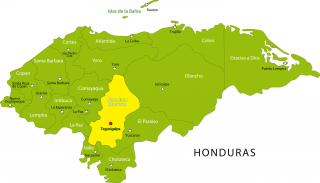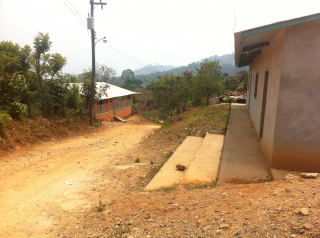Sabaneta, Honduras
![]()
![]()
![]()
![]()
![]()
![]()
![]()
![]() Click on Programs to learn more about their work in this community
Click on Programs to learn more about their work in this community
General Information
| Population* | 350 |
| Number of homes | 79 |
| Avg # of people per home | 4-5 |
| Primary Occupations | Agriculture (corn and beans) |
| Water System | Yes |
| Community Bank | Yes |
| Electricity | Yes |
| Corresponding Health Center & Distance |
CESAMO - Cantarranas CESAR - Naranjal |
| Common Illnesses | Common colds, cough, hypertension, diabetes, fungal infections, parasites |
| School Access and Distance |
Kindergarten - 6th Grade - In community |
| GPS |
N 14°06'00 W 87°06'57 |
| Municipality | Valle de los Angeles |
| Department | Francisco Morazán |
| Distance from compounds | 1 Hour |
* Population does not reflect how many patients will be seen on medical
brigades as many people from surrounding communities come seeking
Medical Brigades medical attention.
Top Three Needs Expressed
The top needs expressed by the key community members are a health center, medicine or a first aid kit, and community health workers.

Sabaneta is located on a mountainside in the central region of Honduras. Due to the altitude, it can be somewhat chilly if it is not sunny outside.
Sabaneta’s educational system includes Kindergarten and Primary school (until 6th grade). There are 15 kindergarten students and 46 students in primary school. The majority leave school after completing 6th grade, although some o continue onto secondary school in the community of Naranjal.
The school consists of 4 classrooms with two teachers. A volunteer also helps with the kindergarten students.
Sabaneta has a water system that was constructed by the government about 30 years ago. Water arrives every day but is chlorinated only once every month.1 The water system is a complex system that uses a small river nearby as its source, shares its connection with several surrounding communities, and has been well-maintained over the years. 100% of homes are connected to the system, and there is a Water Council made up of 6 members.
Sabaneta does not have a health center. The closest health center is roughly 1 hour away in the community of Naranjal. It is only staffed by a nurse however. Thus, those needing to see a doctor must travel to Cantarranas to visit the CESAMO.
The most common illnesses in the community are colds, coughs, hypertension, diabetes, fungal infections, and parasites.
The average family income per month is estimated to be 2300 Lempiras, which is approximately L467 (US $24.70) per person3. The majority of homes are made of adobe. The main form of employment is agriculture on owned land, and the main products that are cultivated in the community are corn and beans. To earn an income, many work in the nearby sugarcane factory from November to May. This job is not stable as they hire on a daily basis. It pays 120 Lempiras or US $6.00 per day.
Although th Microfinance Program has not worked in Sabaneta, there is a community bank led by members of the community.
Sabaneta is a small community near Naranjal. It is connected to the main road via a dirt road that is often in very poor condition, making it difficult for community members to access resources found in Naranjal and Cantrarranas. At the moment, no other organizations work in the community.
Check back soon for pictures!
Source of information: Key informant interview, Centro de Salud statistics
Date of interview: 20 April 2010
1The accepted regulation frequency for chlorinating water is every 4 days.
2CESAMO and CESAR are terms used for types of health centers. CESAMOs are larger, more comprehensive facilities that usually have a physician on staff at all times and occasionally a dentist. CESARs are more remote, less equipped facilities, usually with 1-2 nurses on staff.
3According to Red Solidaria and World Food Programme in Honduras, the average family is approximated at 5 people per household, the poverty line is L930 (US$49.23) per person per month, and the extreme poverty line is L617 (US$32.66) per person per month.
